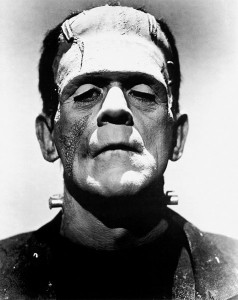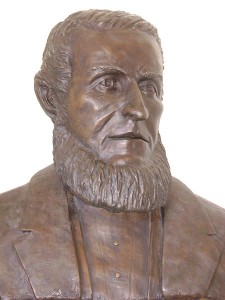I found this odd postmortem about a deceased artist named John Frankenstein in the April 17, 1881 edition of the Brooklyn Daily Eagle. He apparently came from a bohemian family of German immigrant painters and sculptors and had many siblings. (Although the article only mentions a trio of brothers, he also had two sisters.) I can only find a little information online about the Frankenstein artistic dynasty of the nineteenth century, so if anyone out there is an art historian with more knowledge on the topic, please drop me a line.
Although the piece doesn’t say it explicitly, Frankenstein, a recluse with money problems, may have committed suicide. An excerpt from the article, which is subtitled, “What Followed the Completion of Somebody’s Bust”:
“John Frankenstein, the painter, sculptor and poet, who, as briefly related in the Eagle of yesterday, was found dead in the midst of the most squalid surroundings, in a lonely dwelling, located on the extreme southern end of the village of East New York, is, as was discovered after a lengthy search, by a reporter, one of the four brothers of marked ability, well known in different portions of the United States. All of them were painters, who ranked high, but they were all eccentric and possessed of too much theory to enable them to accumulate wealth in this (to a marked extent) practical country. Counselor Sackett of this city, who was well acquainted with them, says they lived in an age which had not progressed sufficiently to appreciate them. They were entirely engrossed in art, as an element that tended to elevate mankind and it was repugnant to their natures to regard it as merely a method of obtaining bread and butter. He has known them to suffer the necessities of life, when by disposing of their work for a fair sum of money they would have been enabled to live comfortably. They were very kind hearted and had they been wealthy, would have been philanthropists. They seemed to think that rich men should endow them, so that they could pursue art without a thought of daily necessities.
They were deep thinkers, and on any subject that was broached, they could converse with more than average ability. One of the brothers is dead. He, as an artist and poet, was far superior to any of the others. Another is a learned mathematician. He holds the position of professor of mathematics in a college in Chicago. Several years ago he created quite a sensation in the scientific world by announcing he had discovered a method whereby the intersection of colored lines at certain angles could produce light. He called this discovery Magic Reciprocals. It was a wonderful discovery, it is said. As yet, no practical use has been made of it.
George Frankenstein, the third brother, is an artist, and has a studio on Broadway in New York City. His paintings are said to be very beautiful and valuable. At one time the deceased was with this brother, but at length he tired of the world, and sought the hermit like retirement which he found in East New York.
His life had been a very sad one, and no one who reads it as depicted in his satire entitled American Art, can fail to be impressed with a feeling of deep sympathy for him. The physician, Dr. F. H. Miller, who saw him several days before his death, is inclined to believe he died of a broken heart. He had been engaged for some time on a bust of great value, and had just completed it, when accidentally he knocked it from the stand upon which he kept it. Falling to the floor, it was irretrievably injured. It seemed to completely crush him, and although he was beginning the work again, he pined away, until he died. His body is at the morgue. It will be claimed by his brother, who will have it interred in Evergreens Cemetery. Among his numerous effects which will be taken charge of by the public administrator, together with the money in the neighborhood of $200, found in his pockets, was a beautiful original poem, entitled “The Falling of Snow,” the first line of which was:
‘I sat at the window and watched the snow fall/
Its mantle of purity thrown over all.'”
More Old Print Articles:
- Four-year-old artistic genius in San Francisco. (1896)
- Brooklyn woman paints her own house, everybody freaks. (1900)
- Profile of an old-time clown. (1896)
- Monkey trained to steal jewelry. (1895)
- Performing bears at Bay Shore. (1895)
- Hobos steal fine clothes from decent folk. (1895)
- General Robert E. Lee kisses pretty girls. (1891)
- Circus Freak gets indigestion after swallowing metal objects. (1904)
- Hairy woman thrown through barbershop window, uninjured. (1897)
- Hunchback paramour has throat cut. (1877)
- Inflated a boy with air. (1900)
- Prisoner gives evil eye to jailer. (1900)
- Three-card monte man passes away. (1878)
- Monkey rides bicycle. (1897)
- Bears brawl in Central Park. (1902)
- Umbrella duels. (1895)
- Boiling eggs with electricity. (1890)
- Billy goat guards recluse. (1900)
- Kissing bandit captured. (1892)
- A maniac gymnast. (1877)
- Brooklyn judge encounters sea monsters in his bathroom. (1902)
- Man finds severed human head, throws head back into creek. (1897)
- Brooklyn geezer tries to shoot noisy dogs. (1896)
- Hoaxer pretends to go over Niagara Falls in a barrel. (1889)
- Manhattan madman goes on rampage. (1890)
- Fisticuffs at a male beauty pageant. (1893)
- Viennese surgeon performs experimental operations in NYC. (1902)
- Tough girl breaks detective’s nose. (1898)
- George Francis Train loses his mind. (1888)
- Organ grinder has monkey kidnapped. (1899)
- Human vampire behaves poorly. (1892)
Tags: Counselor Sackett, Dr. F.H. Miller, George Frankenstein, John Frankenstein


